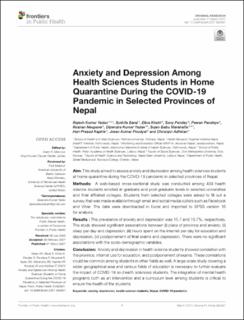| dc.contributor.author | Yadav, Rajesh Kumar | |
| dc.contributor.author | Baral, Sushila | |
| dc.contributor.author | Khatri, Elina | |
| dc.contributor.author | Pandey, Sony | |
| dc.contributor.author | Pandeya, Pawan | |
| dc.contributor.author | Neupane, Roshan | |
| dc.contributor.author | Yadav, Dipendra Kumar | |
| dc.contributor.author | Marahatta, Sujan Babu | |
| dc.contributor.author | Kaphle, Hari Prasad | |
| dc.contributor.author | Poudyal, Jiwan Kumar | |
| dc.contributor.author | Adhikari, Chiranjivi | |
| dc.coverage.spatial | Nepal | en_US |
| dc.date.accessioned | 2022-03-28T09:22:51Z | |
| dc.date.available | 2022-03-28T09:22:51Z | |
| dc.date.created | 2021-09-16T17:33:11Z | |
| dc.date.issued | 2021-03-01 | |
| dc.identifier.citation | Frontiers In Public Health. 2021, 9 1-9. | en_US |
| dc.identifier.issn | 2296-2565 | |
| dc.identifier.uri | https://hdl.handle.net/11250/2987876 | |
| dc.description.abstract | Aim: This study aimed to assess anxiety and depression among health sciences students at home quarantine during the COVID-19 pandemic in selected provinces of Nepal.
Methods: A web-based cross-sectional study was conducted among 409 health science students enrolled at graduate and post-graduate levels in selected universities and their affiliated colleges. Students from selected colleges were asked to fill out a survey, that was made available through email and social media outlets such as Facebook and Viber. The data were downloaded in Excel and imported to SPSS version 16 for analysis.
Results : The prevalence of anxiety and depression was 15.7 and 10.7%, respectively. The study showed significant associations between (i) place of province and anxiety; (ii) sleep per day and depression; (iii) hours spent on the internet per day for education and depression; (iv) postponement of final exams and depression. There were no significant associations with the socio-demographic variables.
Conclusion: Anxiety and depression in health science students showed correlation with the province, internet use for education, and postponement of exams. These correlations could be common among students in other fields as well. A large-scale study covering a wider geographical area and various fields of education is necessary to further evaluate the impact of COVID-19 on (health sciences) students. The integration of mental health programs both as an intervention and a curriculum level among students is critical to ensure the health of the students. | en_US |
| dc.language.iso | eng | en_US |
| dc.publisher | Frontiers Media | en_US |
| dc.relation.ispartofseries | Frontiers In Public Health;March 2021 | Volume 9 | Article 580561 | |
| dc.rights | Navngivelse 4.0 Internasjonal | * |
| dc.rights.uri | http://creativecommons.org/licenses/by/4.0/deed.no | * |
| dc.subject | Anxiety | en_US |
| dc.subject | Depression | en_US |
| dc.subject | Health science students | en_US |
| dc.subject | Nepal | en_US |
| dc.subject | COVID-19 | en_US |
| dc.title | Anxiety and Depression Among Health Sciences Students in Home Quarantine During the COVID-19 Pandemic in Selected Provinces of Nepal | en_US |
| dc.type | Peer reviewed | en_US |
| dc.type | Journal article | en_US |
| dc.description.version | publishedVersion | en_US |
| dc.rights.holder | © 2021 Yadav, Baral, Khatri, Pandey, Pandeya, Neupane, Yadav, Marahatta, Kaphle, Poudyal and Adhikari. | en_US |
| dc.source.articlenumber | 580561 | en_US |
| cristin.ispublished | true | |
| cristin.fulltext | original | |
| cristin.qualitycode | 1 | |
| dc.identifier.doi | https://doi.org/10.3389/fpubh.2021.580561 | |
| dc.identifier.cristin | 1935112 | |
| dc.source.journal | Frontiers In Public Health | en_US |
| dc.source.volume | 9 | en_US |
| dc.source.issue | 9 | en_US |
| dc.source.pagenumber | 1-9 | en_US |

